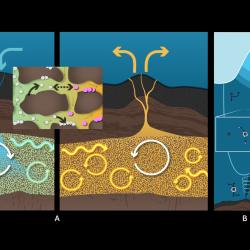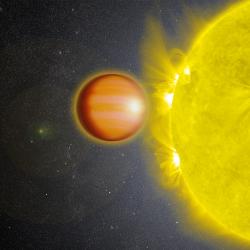Astronomers Map ‘Light Echoes’ of Newly Discovered Black Hole
Team led by UMD postdoctoral fellow reveals the environment around a relatively small black hole in unprecedented detail
An international team of astronomers has charted the environment surrounding a relatively small, “stellar mass” black hole that is 10 times the mass of the sun. The observations provide the clearest picture to date of how these small black holes consume matter and emit energy.
The research results will be presented on January 9, 2019 at a press conference at the 233rd Meeting of the American Astronomical Society in Seattle, Washington. A research paper will also be published in the journal Nature on January 10, 2019.
Using NASA’s Neutron star Interior Composition Explorer (NICER) payload aboard the International Space Station, the team detected X-ray light from the recently discovered black hole, called MAXI J1820+070 (J1820 for short), as it consumed material from a companion star. Waves of X-rays formed “light echoes” that reflected off the swirling gas near the black hole and revealed changes in the environment’s size and shape.
“NICER has allowed us to measure light echoes closer to a stellar-mass black hole than ever before. Previously, these light echoes off the inner accretion disk were only seen in supermassive black holes, which are millions to billions of solar masses and undergo changes slowly. Stellar black holes like J1820 have much lower masses and evolve much faster, so we can see changes play out on human time scales,” said the paper’s lead author Erin Kara, the Neil Gehrels Prize Postdoctoral Fellow in the Joint Space-Science Institute, a collaboration between the University of Maryland’s Departments of Astronomy and Physics and NASA’s Goddard Space Flight Center.
J1820 is located about 10,000 light-years from Earth, in the direction of the constellation Leo. The black hole’s companion star was identified in a survey by the European Space Agency's (ESA) Gaia mission, which allowed researchers to estimate its distance from Earth. Astronomers were unaware of the black hole’s presence until March 11, 2018, when an outburst was spotted by the Japanese Aerospace and Exploration Agency’s Monitor of All-sky X-ray Image (MAXI), also aboard the space station.
In just a few days, J1820 went from a totally unknown black hole to one of the brightest sources in the X-ray sky. NICER moved quickly to capture this dramatic transition and continues to follow the fading tail of the eruption.
“NICER was designed to be sensitive enough to study faint, incredibly dense objects called neutron stars,” said Zaven Arzoumanian, NICER science lead and an astrophysicist at NASA Goddard. “We’re pleased at how useful it’s also proven in studying these very X-ray-bright stellar mass black holes.”
A black hole can siphon gas from a nearby companion star and into a ring of material called an accretion disk. Gravitational and magnetic forces heat the disk to millions of degrees Celsius, making it hot enough to produce X-rays at the inner parts of the disk, near the black hole. Outbursts occur when an instability in the disk causes a flood of gas to suddenly rush inward toward the black hole, like a gaseous avalanche. Astronomers do not yet understand what causes these disk instabilities.
Above the disk is the corona, a region of subatomic particles heated to 1 billion degrees Celsius that glows in higher-energy X-rays. Many mysteries remain about the origin and evolution of a black hole’s corona. Some theories suggest the structure could represent an early form of the high-speed particle jets these types of systems often emit.
Astrophysicists want to better understand how the inner edge of a black hole’s accretion disk—and the corona above it—change in size and shape as a black hole consumes material from a companion star. If scientists can understand how and why these changes occur in stellar-mass black holes over a period of weeks, they could gain new insights into how supermassive black holes evolve over millions of years and how they affect the galaxies where they reside.
One method used to chart such changes is called X-ray reverberation mapping, which uses X-ray reflections in much the same way sonar uses sound waves to map undersea terrain. Some X-rays from the corona travel straight toward us, while others light up the disk and reflect back at different energies and angles.
X-ray reverberation mapping of supermassive black holes has shown that the inner edge of the accretion disk is very close to a black hole’s event horizon— the point beyond which no matter or energy can escape. The corona is also compact, lying closer to the black hole rather than over much of the accretion disk.
Previous observations of X-ray echoes from stellar mass black holes suggested the inner edge of the accretion disk could be quite distant—up to hundreds of times the size of the event horizon. However, J1820 behaved more like its supermassive cousins.
As they examined NICER’s observations of J1820, Kara’s team saw a decrease in the delay, or lag time, between the initial flare of X-rays coming directly from the corona and the flare’s echo off of the disk. This indicated that the X-rays traveled over shorter and shorter distances before they were reflected. From 10,000 light-years away, the researchers estimated that the corona contracted vertically from roughly 100 miles to about 10 miles. To put this in perspective, it would be like seeing something the size of a blueberry shrink to the size of a poppy seed from the distance between Earth and Pluto.
“This is the first time that we’ve seen this kind of evidence that it’s the corona shrinking during this particular phase of outburst evolution,” said co-author Jack Steiner, an astrophysicist at the Massachusetts Institute of Technology’s Kavli Institute for Astrophysics and Space Research in Cambridge. “The corona is still pretty mysterious, and we still have a loose understanding of what it is. But we now have evidence that the thing that’s evolving in the system is the structure of the corona itself.”
To confirm that the decrease in lag time was due to a change in the corona and not the accretion disk, the researchers used a signal called the iron K line, which is created when X-rays from the corona collide with iron atoms in the disk, causing them to fluoresce.
According to Einstein’s theory of relativity, time runs slower in strong gravitational fields and at high velocities. When the iron atoms closest to the black hole are bombarded by light from the core of the corona, the wavelengths of the X-rays they emit get stretched because time is moving slower for them than for the observer.
Kara’s team discovered that J1820’s stretched iron K line remained constant, which means the inner edge of the disk remained close to the black hole—similar to a supermassive black hole. If the decreased lag time was caused by the inner edge of the disk moving even further inward, then the iron K line would have become even more stretched.
These observations give scientists new insights into how material funnels into a black hole and how energy is released in this process.
“NICER’s observations of J1820 have taught us something new about stellar-mass black holes and about how we might use them as analogs for studying supermassive black holes and their effects on galaxy formation,” said co-author Philip Uttley, an astrophysicist at the University of Amsterdam. “We’ve seen four similar events in NICER’s first year, and it’s remarkable. It feels like we’re on the edge of a huge breakthrough in X-ray astronomy.”
Video: Mapping the 'Light Echoes' of a Black Hole
###
The research paper, “The corona contracts in a new black hole transient,” Erin Kara, James Steiner, Andrew Fabian, Ed Cackett, Phil Uttley, Ronald Remillard, Keith Gendreau, Zaven Arzoumanian, Diego Altamirano, Stephen Eikenberry, Teruaki Enoto, Jeroen Homan, Joseph Neilsen, and Abigail Stevens, waspublished in the journal Nature on January 10, 2019.
This work was supported by NASA (Award Nos. HST-HF2-51360.001-A, NAS5-26555, and PF5-160144), the National Science Foundation (Award No. AST-1351222), and the Royal Society. The content of this article does not necessarily reflect the views of these organizations.
Media Relations Contact: Matthew Wright, 301-405-9267, mewright@umd.edu
University of Maryland
College of Computer, Mathematical, and Natural Sciences
2300 Symons Hall
College Park, MD 20742
www.cmns.umd.edu
@UMDscience
About the College of Computer, Mathematical, and Natural Sciences
The College of Computer, Mathematical, and Natural Sciences at the University of Maryland educates more than 9,000 future scientific leaders in its undergraduate and graduate programs each year. The college's 10 departments and more than a dozen interdisciplinary research centers foster scientific discovery with annual sponsored research funding exceeding $175 million.







